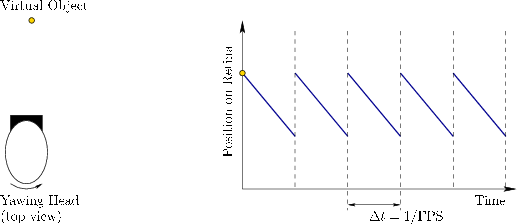
Next: 6.3 Perception of Color Up: 6.2 Perception of Motion Previous: Frame rates Contents Index
 |
Unfortunately, VR systems require much higher display performance than usual. We have already seen in Section 5.4 that much higher resolution is needed so that pixels and aliasing artifacts are not visible. The next problem is that higher frame rates are needed in comparison to ordinary television or movie standards of 24 FPS or even 60 FPS. To understand why, see Figure 6.18. The problem is easiest to understand in terms of the perception of stationarity, which was mentioned in Section 2.3. Fixate on a nearby object and yaw your head to the left. Your eyes should then rotate to the right to maintain the object in a fixed location on the retina, due to the VOR (Section 5.3). If you do the same while wearing a VR headset and fixating on an object in the virtual world, then the image of the object needs to shift across the screen while you turn your head. Assuming that the pixels instantaneously change at each new frame time, the image of the virtual object will slip across the retina as shown in Figure 6.18. The result is a kind of judder in which the object appears to be wobbling from side to side with high frequency but small amplitude.
The problem is that each feature is fixed on the screen for too long when ideally it should be moving continuously across the screen. At ![]() FPS, it is fixed for
FPS, it is fixed for ![]() ms during each frame (in an idealized setting, which ignores scanout issues from Section 5.4). If the screen is instead turned on for only one or two milliseconds for each frame, and then made black during the remaining times, then the amount of retinal image slip is greatly reduced. This display mode is called low persistence, and is shown in Figure 6.19(a). The short amount of time that the display is illuminated is sufficient for the photoreceptors to collect enough photons to cause the image to be perceived. The problem is that at
ms during each frame (in an idealized setting, which ignores scanout issues from Section 5.4). If the screen is instead turned on for only one or two milliseconds for each frame, and then made black during the remaining times, then the amount of retinal image slip is greatly reduced. This display mode is called low persistence, and is shown in Figure 6.19(a). The short amount of time that the display is illuminated is sufficient for the photoreceptors to collect enough photons to cause the image to be perceived. The problem is that at ![]() FPS in low-persistence mode, flicker is perceived, which can lead to fatigue or headaches. This can be easily perceived at the periphery in a bright scene in the Samsung Gear VR headset. If the frame rate is increased to
FPS in low-persistence mode, flicker is perceived, which can lead to fatigue or headaches. This can be easily perceived at the periphery in a bright scene in the Samsung Gear VR headset. If the frame rate is increased to ![]() FPS or above, then the adverse side effects of flicker subside for nearly everyone. If the frame rate is increased to
FPS or above, then the adverse side effects of flicker subside for nearly everyone. If the frame rate is increased to ![]() FPS or beyond, then it would not even need to flicker, as depicted in Figure 6.19(b).
FPS or beyond, then it would not even need to flicker, as depicted in Figure 6.19(b).
One final point is that fast pixel switching speed is implied in the Figure 6.19. In a modern OLED display panel, the pixels can reach their target intensity values in less than ![]() ms. However, many LCD displays change pixel values much more slowly. The delay to reach the target intensity may be as long as
ms. However, many LCD displays change pixel values much more slowly. The delay to reach the target intensity may be as long as ![]() ms, depending on the amount and direction of intensity change. In this case, a fixed virtual object appears to smear or blur in the direction of motion. This was easily observable in the Oculus Rift DK1, which used an LCD display panel.
ms, depending on the amount and direction of intensity change. In this case, a fixed virtual object appears to smear or blur in the direction of motion. This was easily observable in the Oculus Rift DK1, which used an LCD display panel.
Steven M LaValle 2020-01-06